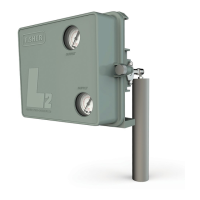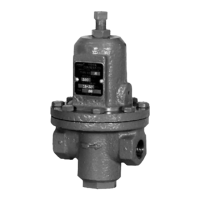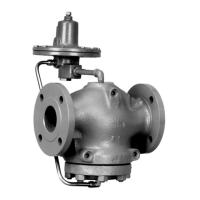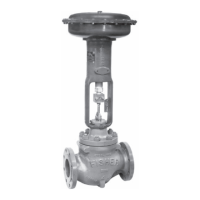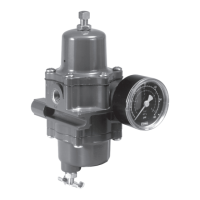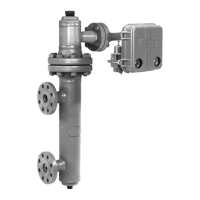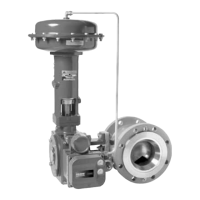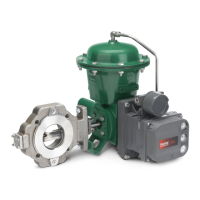4195KA, KB, KC, and KS Controllers
Instruction Manual
Form 5207
April 2007
6-26
5. For a controller with manual set point, move the
set point indicator to the mid-scale mark on the
process scale. For a controller with remote set point,
adjust the remote set point pressure until the set
point indicator is at the mid-scale mark on the
process scale.
6. Apply process pressure equal to the mid-scale
value of the process scale span.
7. The process pointer should be aligned with the
pointer subassembly as shown in figure 6-15. If not,
loosen the zero adjustment locking screw and adjust
the zero adjustment screw to align the process
pointer with the pointer subassembly. Tighten the
zero adjustment locking screw.
8. The process pointer should indicate mid-scale ±3
percent of the process scale span. If not, loosen the
screws in link 1 and adjust the length so that the
process pointer points to the mid-scale mark on the
process scale. Tighten the screws.
9. Apply process pressure equal to the process
scale lower limit.
10. The process pointer should indicate the process
scale lower limit. If not, loosen the zero adjustment
locking screw and adjust the zero adjustment screw
until the process pointer indicates the lower limit.
Tighten the zero adjustment locking screw.
11. Apply process pressure equal to the process
scale upper limit.
12. The pointer should indicate the process scale
upper limit. If not, proceed as follows:
a. If the pointer indicates less than the process
scale upper limit, rotate the pointer span
adjustment clockwise to increase the span.
Adjust the span adjustment screw to correct for
half of the error.
b. If the pointer indicates greater than the
process scale upper limit, rotate the pointer span
adjustment counterclockwise to decrease the
span. Adjust the span adjustment screw to
correct for half of the error.
13. Repeat steps 9 through 12 until the zero and
span indications are within ±1 percent of the scale
limits with no further adjustment. If proper span is
achieved, proceed to step 15. If the span adjustment
screw is adjusted to its limit and the span is still too
short or too long, proceed with step 14.
14. Within the process pointer subassembly, there
are three holes for the connection of link 1. Use
procedure (a.) or (b.) below to make the coarse
span adjustment with link 1.
a. If the span is short (process pointer indication
is less than the process scale upper limit),
disconnect link 1 from the process pointer
subassembly and move the link to the lowest
hole (the hole nearest the pointer pivot). Return
to step 9.
b. If the span is long, (process pointer indication
is greater than the process scale upper limit),
disconnect link 1 from the process pointer
subassembly and move the link to the highest
hole (hole furthermost from the pointer pivot),
and return to step 9.
15. Apply process pressure equal to the mid-scale
value of the process scale span. The process
pointer should indicate mid-scale ±2 percent of the
process scale span. If the process pointer error is ±2
percent or less, proceed to step 17. If the process
pointer error is greater than ±2 percent, loosen the
two Bourdon tube mounting screws (key 384, figure
7-2). Also, loosen the two screws (keys 379 and
380, figure 7-2) holding the process tubing retainer.
16. Slide the Bourdon tube up or down and tighten
the four screws loosened in step 15. Several tries
may be required to determine the direction in which
to move the Bourdon tube to obtain the required
accuracy. Return to step 5.
17. Adjust the process pointer to within ±1 percent
of the mid-scale mark by loosening the zero
adjustment locking screw and adjusting the zero
adjustment screw. Tighten the zero adjustment
locking screw. This distributes the error over the
entire process scale and keeps all points within ±1
percent of the process scale span.
18. Adjust the process pressure to the lower and
upper limits of the process scale span to make sure
the process pointer is still within ±1 percent of the
lower and upper scale limits.
19. Perform the flapper alignment procedure and, if
necessary, the appropriate remote set point
calibration procedure in Section 3, 4, or 5.
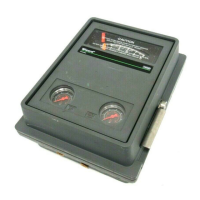
